

UPDATES:
There have been several updates to this review. I've provided the following outline of when additions to the review were made.
You wanted reviews? You asked for it...
BACKGROUND:
First, some background: as with many 950 buyers, this is my first pre/pro. I have advanced through an inexpensive shelf system (late 80's Panasonic) to an inexpensive stereo receiver (early 90's Pioneer) to a Yamaha Pro-Logic receiver (RX-V690, early '97) to the Outlaw 1050 Dolby Digital/DTS receiver in October 2000. Each change provided a noticeable improvement. Separates was a "logical" progression, and I bought an Outlaw 750 amp and used Parasound HCA-800 two-channel amp last year. Even while relying on the 1050 as a pre/pro, I found the amps to be a worthwhile upgrade. Originally I had not planned on replacing the 1050 as pre/pro, but the information that appeared last November on the 950's final feature list intrigued me greatly. I got on the reservation list in the first minute or two after it opened in December, and have been eagerly awaiting the 950 ever since. For those interested, there's an equipment list at the bottom of this page.
As eager as I was to get my hands on a 950, I have grown steadily more and more concerned that it might suffer from the often insane amount of hype generated by forum discussions of the unit. The reviews of the beta testers made me feel better, and worse. Better because the reports indicated that this was the real thing. Not perfect (it would be almost impossible to cram every possible feature into one box at any price, and Outlaw did have to leave some stuff out), but an excellent value with clean sound. Worse because their largely positive feedback served to in some ways fuel the hype. I worried that it would arrive and all the hype would be too much for the 950 to live up to. Look at Phantom Menace (which is playing as I type this) -- it's a decent movie that struggles to set up the story for five movies to follow, but it was so massively hyped that many people felt (and still feel) disappointed in it. The Internet hype machine is powerful, and it can be dangerous. Does this all sound like I'm setting up a way to find fault in the 950? If so, do I have a surprise for you.
THE ARRIVAL:
The DHL man arrived before I had really gotten myself going Saturday morning. Needless to say, I woke up in a hurry. I proceeded to yank out the Model 1050, moved a shelf in the entertainment center, moved my Parasound into the equipment rack for the first time, and slid in the 950. Then (finally) I hooked everything up. By this point, the DHL truck had been gone for at least an hour and a half, maybe longer. For all of you out there with cables that have locking RCA's (Outlaw's PCA, TMC's Yellow Label and White Label, etc.), the 950 jack layout is going to please you: the spacing between inputs leaves room for the big locking connectors to coexist pretty happily (the left and right channels for a given input will rub a little, but it's not really a hindrance and on my 1050 the spacing between inputs was so close that they were tight together in both directions). I plugged the 950's power cord in, fired everything up (after briefly forgetting that I'd turned the main power off on the back during the hook-up), sorted out which wires were from the VCR, and started spinning CD's...
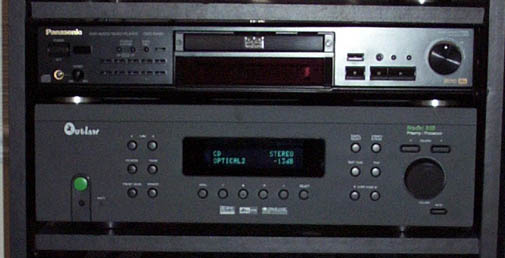
AUDIO/VIDEO:
This is first and foremost a home theater processor. So what about those of us (most of us to one degree or another) who like music, too? The beta testers were unanimously complementary of the 950's sound, particularly the pure stereo and multi-channel (DVD-Audio or SACD) performance. For me, it's been an act of sheer willpower to try sources other than the CD player this weekend -- it is thoroughly transparent to the music, moreso than any system I've spent any time with (except perhaps an audiophile two-channel system I've had a couple opportunities to listen to, which uses Classe pre-amp and amps, KEF Reference mains, and some very nice sources). The stereo bypass mode sounded great, but it didn't take long to find that I preferred the sound of the 950's DAC's to the sound of the DAC's in my Yamaha CDC-775. The best description I can have for the 950's audio is neutral: there seems to be nothing added to or taken away from the original music. I noticed an improvement in sound from the moment I hit "play." As someone who started out in this stuff for the music rather than video, the 950 has met and exceeded my expectations for music listening. I'll be re-visiting a lot of my CD's in the coming weeks, and will add any thoughts I have on music playback here, but so far I've sampled Jewel's This Way, Five for Fighting's American Town disc, Lord of the Rings soundtrack, the new special edition of Toy Matinee, and Indigo Girls' Rites of Passage (basically whatever was in the changer Saturday morning).
I'm using the triple crossover somewhat differently than most, since I don't have a subwoofer (and won't until later this year). My Studio 60's (set to large, with the Studio CC's and ADP's set to small) are currently tasked with the brunt of the bass in my system. While they have performed quite admirably in that role in the past, they took on a slightly more natural and clean bass presence with the 950. At the same time, the highs remain very well balanced -- I had sometimes felt that the system was a little weak in the highs while using the 1050 as a pre/pro, but that sense is completely gone now. Once I add a sub this summer (hopefully), I'll of course be revisiting this, but I think the 950 currently has a nice enough balance that I can continue to live without a sub for a while longer comfortably.
S-Video switching is very good. I had been very pleased with the video switching on the 1050, but I think the 950 is cleaner -- I can find no difference between switching through the 950 and going directly to the TV. I haven't tried the composite / S-Video conversion or the component video switching, as I have everything hooked up via S-Video. It's worth noting that some of the first batch of users did have problems with the S-Video switching and Outlaw reportedly has identified and resolved the problem, but I can not confirm the existence of such a bug; if it exists, someone forgot to tell my 950 and Mitsubishi TV because they have worked together flawlessly with everything I've tried on them.
DIGITAL PROCESSING:
As I said above, the Model 950's main purpose for existence is as a home theater processor. As such, it is equipped with a wide range of processing modes. These include: Dolby Digital, Dolby Digital EX, DTS, DTS-ES, Dolby Pro Logic II (both Cinema and Music, as well as the original Pro Logic if you are nostalgic), DTS NEO:6 (both Cinema and Music), Cirrus Extra Surround (to provide surround back decoding for modes that lack that), and both 7 channel and 5 channel stereo modes. That's a lot of options. Personal taste will dictate which modes different people prefer for different roles (some people will probably leave the CD input locked on 7 Stereo, while others may prefer Pro Logic II Music or good old Stereo). I can't say what you will like, but in lieu of that I will offer a few of my thoughts on the different modes.
A couple of the early 950 owners reported some odd drop-outs with Dolby Digital and DTS playback. I was able to witness this behavior only a handful of times (I think perhaps four times in a week, maybe five). A week after the first reports of this drop-out made their way back to the Outlaws, Steven Simon (a moderator in the receivers/separates/amps forum at Home Theater Forum and one of the people who received one of the first of the Model 950's) reported on Sunday, April 14 that Outlaw had identified the problem and shipped him a fixed unit that run for six hours without a drop-out. From what I understand from Outlaw, there were several other units used during the search for this bug that were similarly fixed and also heavily tested -- all proved "rock solid" after the fix was applied. That is the last major hurdle between the Model 950's and the home theater enthusiasts eagerly (and even sometimes impatiently) awaiting their arrival. With that said, on to a summary of the different processing modes included in the Model 950.
There are basically three scenarios to keep in mind when trying to understand the Model 950's bass management. The most hotly-debated scenarios are the "Direct 5.1" and "Stereo Bypass" modes. For both of these modes, there has been concern by some people online that the 950 may be "doubling" the bass sent to the subwoofer. Outlaw maintains that in real-world operation and use, this "double bass" is not a problem. The "Direct 5.1" and "Stereo Bypass" modes are both capable of being configured to produce this "double bass" scenario. Personally, I have not been bothered by the issue, but that is largely because my gear is well-suited to using modes that avoid this condition entirely (I use the analog bass management on the 6-channel input and do not make use of the stereo bypass mode at all). There is also the most heavily-used scenario, which is be bass management used for everything else -- the full digital bass management (used for all digital inputs and any analog inputs that are not switched to "Stereo Bypass"). The "double bass" condition is not applicable to this bass management scenario at al. Below is an outline of the behavior for each case.
RADIO:
Remember all the fuss during the beta test about the radio section? The Outlaws asked the beta testers not to worry with it because they'd already decided to replace it. The replacement is pretty slick for a basic on-board tuner section. The 950 comes with a fancier FM antenna than I've seen with any of my receivers, which was a nice touch. Reception is excellent -- the 950 pulled in stations that the 1050 and my Yamaha RX-V690 before it always struggled with. The sound is well-matched to the rest of the 950's sound, very clean. I'm not much of a radio listener, but I may listen more now. I guess that is a pretty good complement for the radio section.
SETUP:
The OSD's are well laid-out, and for those of you with component video who won't be able to see the OSD the good news is that the front display is sufficient to do everything. I do want to make one observation here. The Model 950 (and the other notable pre/pros: the Rotel 1066, Anthem AVM-2 and AVM-20, B&K Reference 30, whichever you pick) is crammed full of features, many of which are tied into digital processing, bass management, time delays, and a slew of other stuff. The level of complexity is high, which means a lot more challenge for the designers of these units and it can quickly make the end-user's job of understanding it all a lot more difficult than was the case with older gear. This thing is in one sense nothing more than a purpose-built computer. I think a lot of the 950 buyers are going to have a LOT of questions -- it's a big change from many receivers (especially older ones and entry-level ones). The manual is pretty good about explaining, but it's worth keeping in mind that there's a lot going on here -- if it seems overwhelming, it's not just you. Robert Fowkes has mentioned that Outlaw is apparently planning to supplement the manual with some online references that will go into greater detail on the "tweaking" of the 950 and of some of the hidden features, which will likely be very useful.
REMOTE:
![]() Mrs. Gonk (gonk's better half) informed me Sunday evening that she approves of the new remote. It is the third universal remote that I've used to address the "coffee table o' remotes" syndrome. The Model 1050's remote served in this role admirably, but was retired last fall when I received a Sony RM-AV2100 touchscreen universal remote as a birthday gift. The AV2100 is nice, but the touchscreen can sometimes be a pain and the cats have a habit of walking on it and changing the channel or the input. The Model 950's remote is also a more manageable size than the AV2100 (almost exactly the same size as the Model 1050's remote, although with a boxier shape), and it's been nice to be able to hold and operate a remote with one hand again after using two hands for most everything except changing volume on the AV2100. After spending a week with the Model 950's remote, I have become very comfortable with it; the AV2100 is sitting rather forlornly on a bookcase at the moment, ignored by both myself and my wife. It didn't take me all that much time to get all of the various devices set up on the Model 950's remote. This is basically the Home Theater Master SL-9000 with the LCD removed -- it shows up with a lot of other pre/pros, and there are plenty of people using either the off-the-shelf version of one of the OEM versions. The only weakness I've found is a need to teach the remote the transport commands and navigation keys for your DVD player because they are all combined on the same buttons; this is a common complaint about the 9000, but is surprisingly easy to work around. I found a few spare buttons and assigned the basic transport stuff to them (CR SURR is now play, STEREO and T.MODE are rewind and fast forward, SLEEP is stop, and P.SCAN is pause); I may get out a marker eventually and draw small transport symbols on the buttons, but so far I've had no trouble remembering where they were. The "light" button is easy to find in the dark and my wife was pleased to notice that it is even labeled clearly as "LIGHT" (as compared to the Radio Shack 15-1994's small light button which is marked with what is supposed to be a light bulb). Also, the "buzzing" that is sometimes associated with illumination on remotes like this is effectively non-existent. I did hear it once, when I turned on the light and pressed the keypad against my ear. Otherwise, it is completely silent, and the light is only active when the "LIGHT" button is used, so it will be less of a drain on the batteries. One particularly nice feature of the 950's remote is the ability to switch decoding modes quickly: there are buttons for Dolby, DTS, CES, and stereo that allow you to scroll through the options for each category quickly. This makes it easy to switch from Pro Logic II Music to pure stereo in one step, or scroll through "7 Stereo", "5 Stereo", and "Stereo" without having to also go through all of the Dolby, Cirrus, and DTS modes along the way. For a useful macro trick that users of the AUX1, AUX2, and 6-channel inputs might appreciate, check this update below.
Mrs. Gonk (gonk's better half) informed me Sunday evening that she approves of the new remote. It is the third universal remote that I've used to address the "coffee table o' remotes" syndrome. The Model 1050's remote served in this role admirably, but was retired last fall when I received a Sony RM-AV2100 touchscreen universal remote as a birthday gift. The AV2100 is nice, but the touchscreen can sometimes be a pain and the cats have a habit of walking on it and changing the channel or the input. The Model 950's remote is also a more manageable size than the AV2100 (almost exactly the same size as the Model 1050's remote, although with a boxier shape), and it's been nice to be able to hold and operate a remote with one hand again after using two hands for most everything except changing volume on the AV2100. After spending a week with the Model 950's remote, I have become very comfortable with it; the AV2100 is sitting rather forlornly on a bookcase at the moment, ignored by both myself and my wife. It didn't take me all that much time to get all of the various devices set up on the Model 950's remote. This is basically the Home Theater Master SL-9000 with the LCD removed -- it shows up with a lot of other pre/pros, and there are plenty of people using either the off-the-shelf version of one of the OEM versions. The only weakness I've found is a need to teach the remote the transport commands and navigation keys for your DVD player because they are all combined on the same buttons; this is a common complaint about the 9000, but is surprisingly easy to work around. I found a few spare buttons and assigned the basic transport stuff to them (CR SURR is now play, STEREO and T.MODE are rewind and fast forward, SLEEP is stop, and P.SCAN is pause); I may get out a marker eventually and draw small transport symbols on the buttons, but so far I've had no trouble remembering where they were. The "light" button is easy to find in the dark and my wife was pleased to notice that it is even labeled clearly as "LIGHT" (as compared to the Radio Shack 15-1994's small light button which is marked with what is supposed to be a light bulb). Also, the "buzzing" that is sometimes associated with illumination on remotes like this is effectively non-existent. I did hear it once, when I turned on the light and pressed the keypad against my ear. Otherwise, it is completely silent, and the light is only active when the "LIGHT" button is used, so it will be less of a drain on the batteries. One particularly nice feature of the 950's remote is the ability to switch decoding modes quickly: there are buttons for Dolby, DTS, CES, and stereo that allow you to scroll through the options for each category quickly. This makes it easy to switch from Pro Logic II Music to pure stereo in one step, or scroll through "7 Stereo", "5 Stereo", and "Stereo" without having to also go through all of the Dolby, Cirrus, and DTS modes along the way. For a useful macro trick that users of the AUX1, AUX2, and 6-channel inputs might appreciate, check this update below.
CLOSING THOUGHTS:
In my book, the Model 950 is a winner. The only thing keeping it from being a slam-dunk at the moment is the need to resolve the mysterious audio drop-out, but I have spoken to Outlaw about it and know that they are very agressively pursuing a solution to it (as I mentioned in my review, it's tricky since none of the beta units exhibited the problem and it's very difficult to reproduce in the production units). Since I haven't been able to reproduce the problem more than a couple times, it hasn't directly affected me so far. Once the drop-out bug is squashed, it will qualify as a great success in my opinion. If you are looking for a reasonably-priced pre/pro with good video switching and great sound, this may be the way to go. As some people have vocally noted in online forums, there are some setting/control features that were left out -- some people will have a hard time parting with some of those features if they already have them. For many, many users, however, the 950's plentiful range of features and it's extremely impressive sound will be sure to please. I expect to spend the first couple weeks that I have it trying a lot of different things with my 950 and answering a lot of questions from people online, but I also expect to spend the next several years enjoying it.
Still reading this? Thanks for hanging around. I'll be adding to this review some as I get more time with the unit, but I went ahead and posted this now to help get some information to the people who are waiting for their own 950's or considering buying one soon. I hope that it was of some use to you.
As of today (tax day, April 15, 2002), I'm wrapping up this review. I may add to the end of it in the future, after I get my "fixed" Model 950 and get more experience with it (and I plan to have this unit in my equipment rack for a long time to come).
UPDATE:
When the Model 950 started shipping, it faced some very, very high expectations. Some people wanted the 950 to provide everything -- every feature they could ask for, great sonic performance without any blemishes, a tiny price tag (for a pre/pro), and perhaps even a pony (don't ask...). Because of those expectations, the 950 caught a great deal of grief in the weeks before it first arrived, as details from the beta testers revealed specifics about the unit's feature set. Limitations in the speaker calibration were a sticking point for some people, and there was a great deal of debate about bass management for the 5.1 analog input and the stereo bypass mode. The truth of the matter is that (based on my experience using a Model 950 for over a month and a half now) the Model 950 pre/pro is an inexpensive home theater pre-amp/processor that provides extremely good sound and the latest processing modes at a reasonable price. TANSTAAFL is a universal truth: "There Ain't No Such Thing As A Free Lunch." You can't get the sound quality, flexibility, and full feature set of a $3,000+ pre/pro (Anthem AVM-20, Lexicon, ...) for $900. You can get very, very close on some of that, though -- the 950 sounds absolutely great, offers a robust selection of processing modes, and has a core feature set that will be sufficient for many users. If you do not need all of the flexibility provided by those more expensive units (or would really like the flexibility but can't afford it), the 950 offers a great value.
There has been a fair bit of talk online about the remote's ergonomics and about hum on some units. The remote (as with all remotes) is a personal preference. I've been generally very satisfied with the remote, but your mileage may vary. As for the hum, I've fought with ground loop hum and power noise for over a year (it's not good to have the refrigerator and microwave on the same circuit as the home theater), and only shortly before the arrival of my 950 I had a dedicated circuit put in the for home theater. That combined with a power conditioner has effectively silenced my ground loop hum problems, and the 950 has not caused me any problems in this regard.
The sound of the unit continues to be extremely satisfying. The Cirrus Extra Surround is a great feature for anyone moving to a 6.1 or 7.1 speaker configuration and wanting to get full use of the extra speaker(s). Pro Logic II has been great for TV watching and the occasional Dolby 2.0 DVD. Perhaps most impressive to me has been the CD performance. And very recently I've begun playing with DVD-Audio thanks to a new Panasonic DVD-RA60 player, with very good results. I'll be reviewing the RA60 here on the site after I have a little more time using it.
August 20, 2002
May 24, 2002
I created this review about a month and a half ago and updated it some shortly afterward. In the weeks since then, I've gotten a good bit more familiar with the Model 950, and I've spent several weeks now with the "final" Model 950. I wanted to add some of my thoughts now that 950's are shipping in quantity and I have the final version of the unit.
First, I wanted to include the bass management settings that I'm using now that I've got a subwoofer in the system. I now have an SVS 25-31PCi powered subwoofer in the system, and am using the following bass management settings:
| Speakers | Large/Small | Crossover | Speaker Performance, +/-2dB | |
| Mains: | small | 40Hz | 42Hz-22kHz (30Hz, -3dB) | |
| Center: | small | 80Hz | 70Hz-22khz (42Hz, -3dB) | |
| Surrounds: | small | 100Hz | 75Hz-22kHz (50Hz, -3dB) |
One quirk of the 950's remote that I discovered when I added a DVD-Audio player to my system was the fact that the device buttons at the top of the remote can be a problem when trying to control a device (such as a DVD player) while using an input that is different from the device's standard input (such as the 6-channel analog input instead of the DVD input). What's the problem? Well, you have to switch to the "AUD" device (the 950) to select the 6-channel input, but then when you hit the "DVD" button to actually control the player, it switches back to the DVD input. This problem also applies any time you want to use the AUX1 or AUX2 inputs with a source that you want to control with the 950's remote.
One solution is to cover the front of the remote when you hit the "DVD" button. I did this for a few months, and always felt sort of silly doing it. Another solution, the one that I discovered recently and am now using, is to use a macro to send the command to change inputs. The process: for the CD, DVD, or AUX (TAPE) devices, do the following. (1) Hold down AUD and MUTE together. (2) Select the macro button you want (I'm using M3 for the 6 CH for my DVD player). (3) Select the AUD button. (4) Select the input you want (AUX1, AUX2, or 6 CH). (5) Select the channel up button to save the macro. For the SAT, TV, VCR, and CBL devices, change step (1) and hold down the SAT and MUTE buttons (I think -- haven't actually tested that, but that's what the 950 manual and the SL-9000 manual both indicate).
I've now got my remote set up so that when I'm using the DVD device (my Panasonic DVD-RA60 player), I can hit M3 and switch to the 5.1 analog input. I never have to press the "AUD" button, so the remote's "focus" never leaves the DVD player. I can also hit M4 and switch to AUX2, which uses the same digital input as DVD but is set up to play in stereo -- so I can use the DVD player as a two-channel CD transport (mainly for some CD-R's that my Yamaha doesn't like or MP3 CD-R's if I want) without having to change the default processing on the DVD input. The M1 button for the bottom row of device buttons (SAT, TV, VCR, and CBL) is a power-on macro that turns on the digital cable box and TV, and the M2 button for the bottom row of the device buttons is a power-off macro that turns off the digital cable box, TV, and 950.
August 29, 2002:
There have apparently been a few software tweaks along the way, too, and my test unit (as they were quick to tell me before I even got the new unit unboxed) has a setup quirk. The 950 has to be in a surround mode for the test tones to work on all of the channels. If you have the 950 in stereo mode when you go to calibrate with the test tones, the unit will show that it's sending all of the tones but will only send tones to the mains and sub. Pro Logic II will do fine for a surround mode (I tried it, in case it actually was looking for a multi-channel input), so even if you are using nothing but stereo analog connections to the 950 you won't have a problem. I don't know if this behavior applies only to the samples they are testing, but they wanted me and others to be aware of it. The new 950 is also a couple of dB quieter, so when I set my speaker levels I ended up bumping them all up a dB or two. Those are the only real differences I could find between the old unit and the new unit. The "standby" lights blinked out of sequence on the two when they were both paused at the same time, but I don't think that really matters.
September 30, 2002:
December 25, 2002:
January 17, 2003:
Once the 950 had broken in a bit, I did quite a bit of DVD watching and CD listening. The blue dot has a higher gain than either the original or red dot versions, so all of my channel trim settings were lower than in the past. I could definitely see some people with larger spaces, less efficient speakers, or a profound love of really reference level listening enjoying the extra headroom -- I could have easily calibrated the system for 85dB at a volume level of 00 rather than 75dB, something which would have been difficult to do with the red dot revision. Since I typically listen with the volume between -25 and -05 (depending on the source and who else is in the room), I saw no reason to do so, and I never had any problem with the 4dB reduction in headroom on the red dot 950's. As for the unit's sound, I could find no difference in sound between the previous 950's and the new unit. The Model 950 continues to perform beautifully. Pre/pros with more robust feature sets exist, and some of those will offer superior performance for two-channel listening, but they have price tags to match. I don't believe anything in the 950's price range can seriously challenge it (the Rotel 1066 is comparable, with reportedly a less forward and detailed sound that may work better in certain systems, but it retails for around $600 more than the Model 950 and will cost you at least $300-$350 more). Anyone with an older Model 950 and no problems currently should feel very comfortable sticking with the unit already sitting in their rack. Anyone with high-sensitivity speakers like Klipsh horns who has been looking at the Model 950 but was concerned about hiss can now lay those concerns to rest.
The pictures above give some idea of the process involved in replacing the E-PROM. All new Model 950's shipped since late March 2003 include the new software, and owners of older units that exhibit this bug have several options available to them if they need the fix but don't want to try to do it themselves. It is a straight-forward and well-documented process, and I was impressed with Outlaw's rapid response to the problem.
I hope that this review can be of help to anyone shopping for a good, inexpensive home theater pre/pro. For now, I believe that it is finished, but I will of course update it later if anything crops up.
EQUIPMENT LIST:
-- gonk
During much of the summer, shipment of new Model 950's was halted while Outlaw pursued a complaint of audible hissing from some units. It was not a universal problem, as many units did not exhibit noticeable noise. Nonetheless, Outlaw went back and made some design changes in order to reduce the unit's noise floor. On August 22, I received a sample 950 with these fixes incorporated. Over the several days that followed, I tested this revised unit for potential problems or changes relative to my old Model 950 (which had been one of the units that did not have a hiss problem). I was one of several consumers conducting similar at-home tests of the new 950.
The new 950 has a significantly reduced noise floor. At Outlaw's suggestion, I switched the new 950 to an analog input (CD player, specifically, set to analog rather than digital) and turned it up to +10dB -- with no CD playing, of course -- to see what sort of hiss I might be able to get. I had to get within 6" to 12" of the tweeters on my mains to hear anything. At my listening position (a little over 6' from the speakers, probably), it was dead silent. For comparison, the center channel (which was getting no signal from the 950) had a hiss at about 2" distance simply due to the system - interference from power cords and the like. I think that would qualify as "fixed". For digital inputs, the results were quite a bit quieter. As an additional comparison, I hooked my old 950 back up and repeated the test. I had never noticed a hum or hiss problem at my listening position during normal use, but I discovered that at +10dB on an analog input with no signal there was a hiss from the old 950 that could be heard at the listening position. (I'll spare you the look my wife gave me when I told her about this test -- neither of us have noticed any objectionable noise from our old 950, and she considered this "max volume, no sound" test sort of silly. Can't say I blame her. ) For people experiencing an objectionable hiss currently, the new 950 should be a real eye-opener.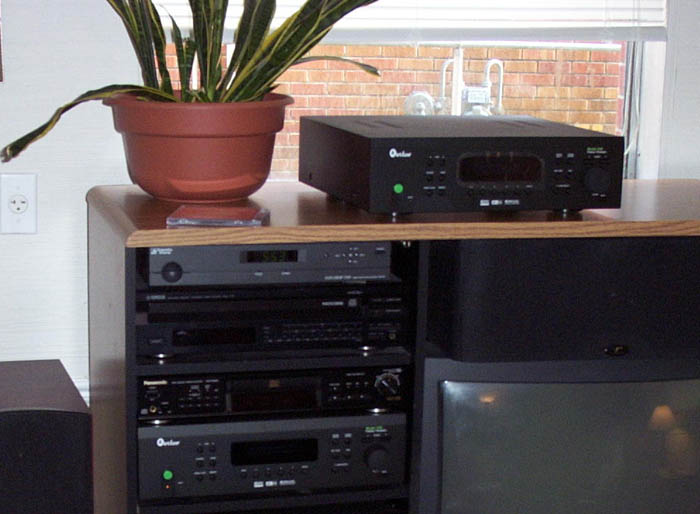
New 950 (with plastic still over the front panel display) ready to be installed in the equipment rack.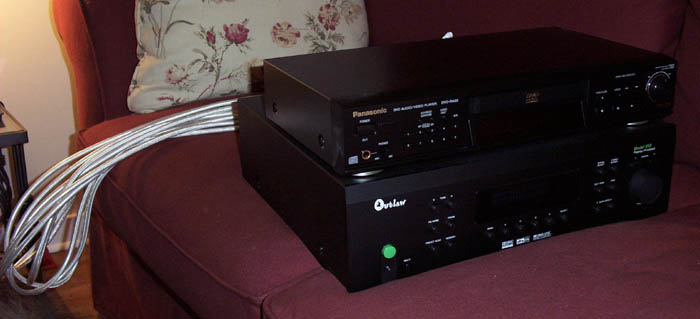
Old 950 and the Panasonic DVD-RA60 pulled out of the rack.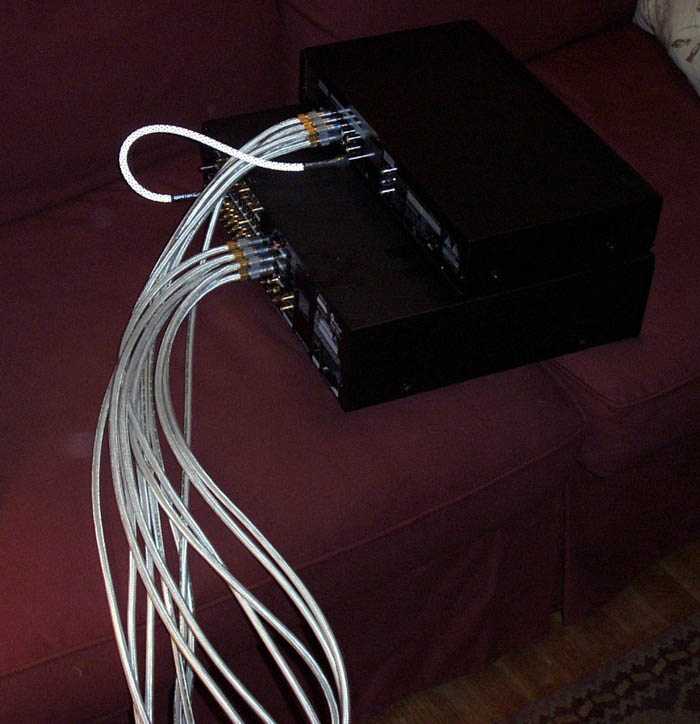
I really need to pick up a set of 0.5-meter PCA interconnects for the DVD-Audio...
What about the sound of the new unit in general? Outlaw asked me to do an A/B comparison between the new unit and the old one, using some fairly revealing material if possible, to see if I could hear any difference and if there were any sonic trade-offs on the new unit. They didn't want to turn loose the new fixes if the result would lessen the 950 in any way. So I did some back-and-forth testing. Both units were connected to my Model 750 amp with the same type of cables, both were using optical cables to connect to my Yamaha CD changer, and both had the mains set to "large" so the sub wasn't involved (saved me switching the sub between the two units). My initial tests were done with the Theater Compensation mode inadvertently turned on on the new unit and off on the old unit. Before I caught that mistake, I found a few discs where my wife noted that the highs were more pronounced on the old unit (she actually considered them harsher). It showed up on tracks with a lot of cymbals, chimes, or high and very sibilant vocals when the volume was up around -15dB. The new unit's Theater Compensation, of course, was tempering those highs. Once I caught my mistake, I re-visited some of the more revealing tracks. With both units using Theater Compensation, I could not distinguish between the two units at all. With Theater Compensation off on both units, I felt like the reduced noise floor on the new 950 was showing through, as it seemed like the sound might be a bit clearer or cleaner, particularly the highs. It was a very, very slight difference though - for anyone with a 950 that isn't exhibiting hiss, you'll be hard pressed to find a difference between the one you have and a new 950.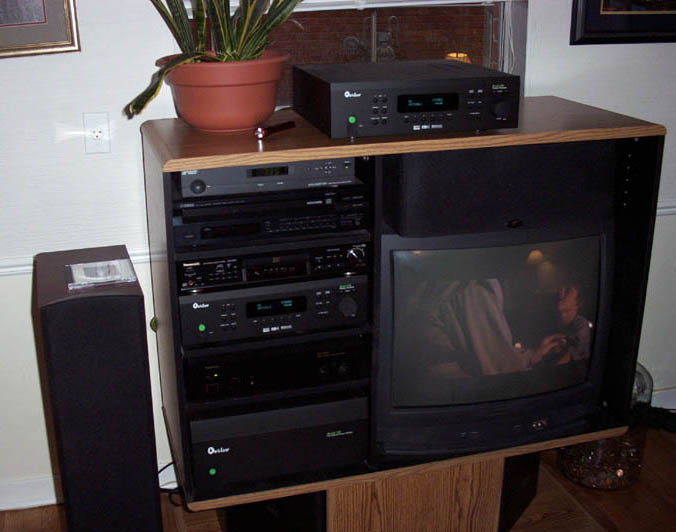
I had both units set up so it only took switching three cables to change between the old and new 950's for some two-channel sound tests. The old 950 is on top of the entertainment center.
Just a brief update here -- I added an outline of the Model 950's bass management features here.
In a newsletter sent out by Outlaw Audio on Christmas Eve, it was reported that they had developed and implemented a modification to the Model 950 that resolved the lingering hiss problem reported by a handful of 950 owners (approximately 2% of the users, according to Outlaw). As of December 17, all new 950's sold include this fix. Based on reports from users in Outlaw's forum who have begun receiving replacement units and some new owners using highly sensitive gear (horn speakers, etc.), this revision ends the hiss battle for all users. Anyone considering a 950 who has been worried by the reports of hiss in some systems can rest easier now, and anyone with a 950 already in there rack who has experienced this hiss should drop Outlaw a line so that they can get you taken care of.
I received a "blue dot" revision of the Model 950 on January 9, 2003, and hooked it up late that night. As I have mentioned previously, my system had not exhibited objectionable hiss using the "red dot" revision, but my testing of that revision had me on the "hiss list" so I ended up swapping out units anyway. The "blue dot" revision of the 950 (which is applied to all 950's shipped after December 17, 2002) is the end product of over six months of design work to track down and eliminate an objectionable hiss noted by a small portion of 950 owners. As unfortunate as this long process was, it speaks highly of Outlaw's determination to make things right for their customers. Any 950 owner who encounters an objectionable hiss (audible at several feet from the speaker with nothing playing) from a Model 950 purchased before December 17, 2002 should contact Outlaw to arrange for an exchange or to return their existing unit for a blue dot upgrade.
After half an hour of labor and another half hour or so setting speaker levels and other preferences, I was back in business. That first night, the system seemed a little bright, but it hadn't burned in yet and the sub was still unplugged. I waited a day or two before listening to it real closely (more because of schedule limitations than any intentional choice), and by the time I started spinning some DVD's and CD's the initial brightness (much more pronounced than any previous 950's I've used have exhibited) was gone. Several other people have commented online about the blue dot 950's definitely benefiting from some burn-in, so perhaps some of the components changed in the blue dot revision need a bit more burn-in time to settle in than the old components. Either way, I'd recommend a day or so of casual use before trying to decide how the 950 really sounds.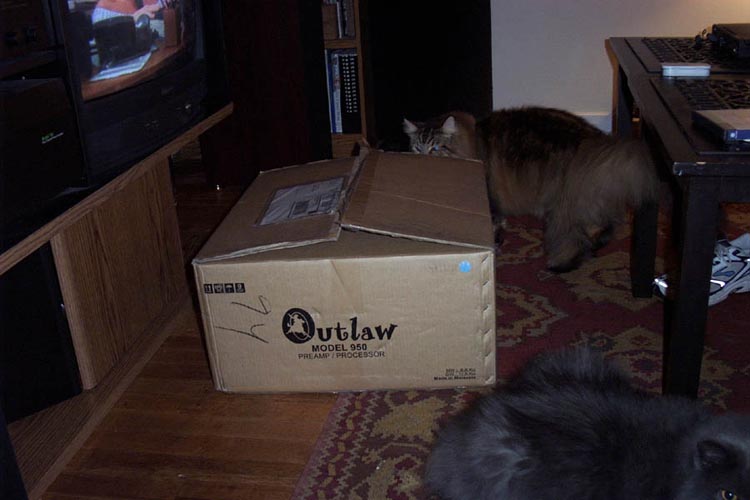
There it is, the blue dot...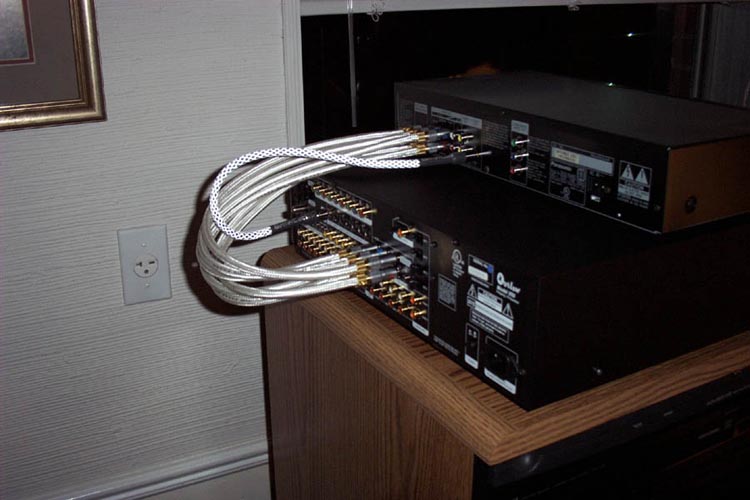
There's a bit of wire-shuffling involved in swapping out pre/pros in my system. The DVD player (a Panasonic DVD-RA60) includes DVD-Audio support, so there are a few audio interconnects to hook up. Thankfully I replaced the 1.8-meter interconnects with 0.5-meter cables at Christmas.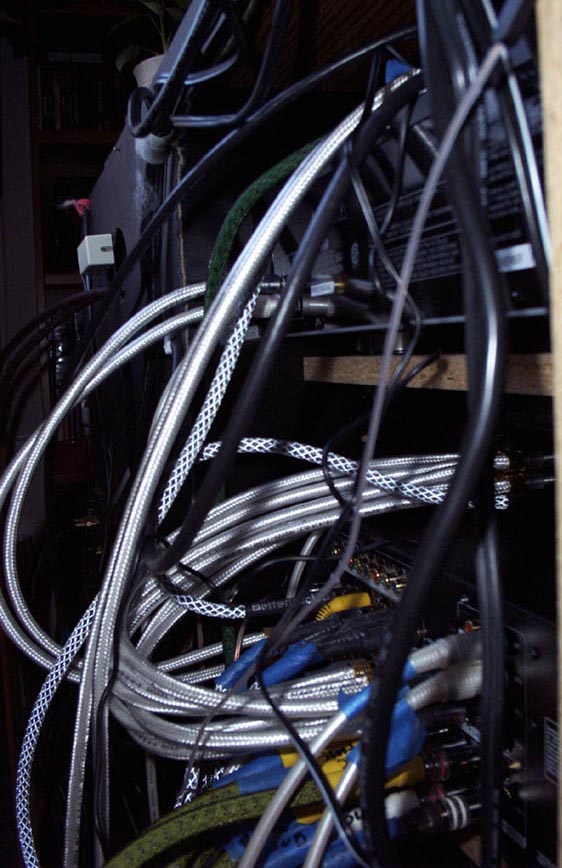
In addition to the DVD-Audio cables, there are just a few other cables behind the equipment rack. The 950 is at the bottom of the picture, with the two amps below it.
April 8, 2003:
Before I could get the "red dot" unit back in the box and shipped back, both cats decided to camp out on top of it...
In March, 2003, a 950 user discovered a bug in the 950's DTS software that caused the LFE channel of DTS-ES soundtracks to be discarded when the main speakers were set to large. Outlaw tracked down the bug in a bit of software contained in a removeable E-PROM on the 950's digital input board, and in mid-March they began accepting requests for the upgrade. 950 owners were given the option of shipping their units to Outlaw for the upgrade or having a replacement chip, instructions, and an extractor shipped to them. In the latter case, a stamped return envelope was included for the owner to use to return the original chip and the extractor; the owner could then take their unit to a local service center and have the chip swapped. Outlaw agreed to pay up to $48 in service fees from a reputable service center if a receipt was included. Outlaw does not suggest that the owner attempt the upgrade themselves, but they do not forbid it either, and the instructions provided with the kit are extremely clear and detailed. I received my kit on April 7 and installed it that evening. The process took approximately 50 minutes, including 25 minutes to remove my 950 from the equipment rack and put it back afterward. Opening the 950 and replacing the chip took 15 minutes, and closing it back up took 10 minutes (less, actually, since I received a phone call about half-way through the re-assembly). It was a fairly straight-forward process that was made significantly simpler by Outlaw's excellent instructions.
OTHER ONLINE REVIEWS:
If you have any questions about this review, click here and I'll get back to you as quickly as I can.
[an error occurred while processing this directive] hits since April 8, 2002